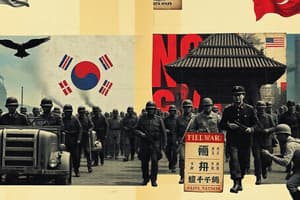Podcast
Questions and Answers
By July of 1950, North Korean forces had pushed South Korean forces as far south as?
By July of 1950, North Korean forces had pushed South Korean forces as far south as?
- Pyongyang
- Pusan (correct)
- Seoul
- Inchon
In the years following World War II, the United States established a policy of containment to?
In the years following World War II, the United States established a policy of containment to?
- Ensure that communism was contained to the Soviet Union only
- Eliminate all communist governments throughout the world
- Prevent the spread of communism outside of Eastern Europe (correct)
- Keep the countries of Eastern Europe from becoming communist
When fighting began in the Korean War in 1950, what major advantage did North Korea possess?
When fighting began in the Korean War in 1950, what major advantage did North Korea possess?
- North Korea was led by Syngman Rhee
- North Korea had the support of the United Nations
- North Korea had a huge number of troops (correct)
- North Korea was led by Douglas MacArthur
Which of the following statements best describes the course of the Korean War during the last year-and-a-half of the conflict?
Which of the following statements best describes the course of the Korean War during the last year-and-a-half of the conflict?
Which of the following statements best describes why President Truman fired General Douglas MacArthur in 1951?
Which of the following statements best describes why President Truman fired General Douglas MacArthur in 1951?
Which of the following statements best describes the state of the Korean Peninsula after World War II?
Which of the following statements best describes the state of the Korean Peninsula after World War II?
The Korean War officially began in 1950 when?
The Korean War officially began in 1950 when?
During the first battle of the Korean War in June of 1950,?
During the first battle of the Korean War in June of 1950,?
Which country became involved in the Korean War to stop the spread of communism?
Which country became involved in the Korean War to stop the spread of communism?
When WWII began, which country controlled Korea?
When WWII began, which country controlled Korea?
Flashcards are hidden until you start studying
Study Notes
Korean War Overview
- The Korean War officially started in 1950 when North Korea invaded South Korea by crossing the 38th parallel.
- North Korean forces advanced rapidly, pushing South Korean troops to Pusan in the south.
Policies and Impacts
- Post-World War II, the United States established a containment policy aimed at preventing the spread of communism outside Eastern Europe.
- The war was part of a broader struggle to limit communist influence during the Cold War.
Military Dynamics
- North Korea enjoyed a significant advantage at the beginning of the war due to a large number of troops.
- The United Nations intervened to support South Korea, marking a key multinational effort against communist expansion.
- By the war's later stages, progress stalled with neither side gaining a decisive advantage, resulting in a stalemate.
Key Figures and Leadership
- General Douglas MacArthur led U.N. forces during the conflict but was relieved of command by President Truman due to disagreements over war strategy and public criticism of Truman's policies.
- Syngman Rhee was the president of South Korea during the conflict, while North Korea was led by Kim Il-sung.
Aftermath of World War II
- The Korean Peninsula was divided after World War II, with South Korea adopting democratic governance and North Korea becoming a communist state.
- Japan had historically controlled Korea until the end of World War II, after which the division occurred.
Significant Battles and Events
- In June 1950, North Korean troops captured Seoul, the capital of South Korea, early in the war.
- The conflict saw heavy casualties and was marked by significant territorial shifts and military engagements.
Involvement of External Powers
- The United States became heavily involved in the Korean War with the objective of stopping the spread of communism, reflecting its Cold War policies.
- China and the Soviet Union had interests in the region, supporting North Korea's communist government.
Studying That Suits You
Use AI to generate personalized quizzes and flashcards to suit your learning preferences.




